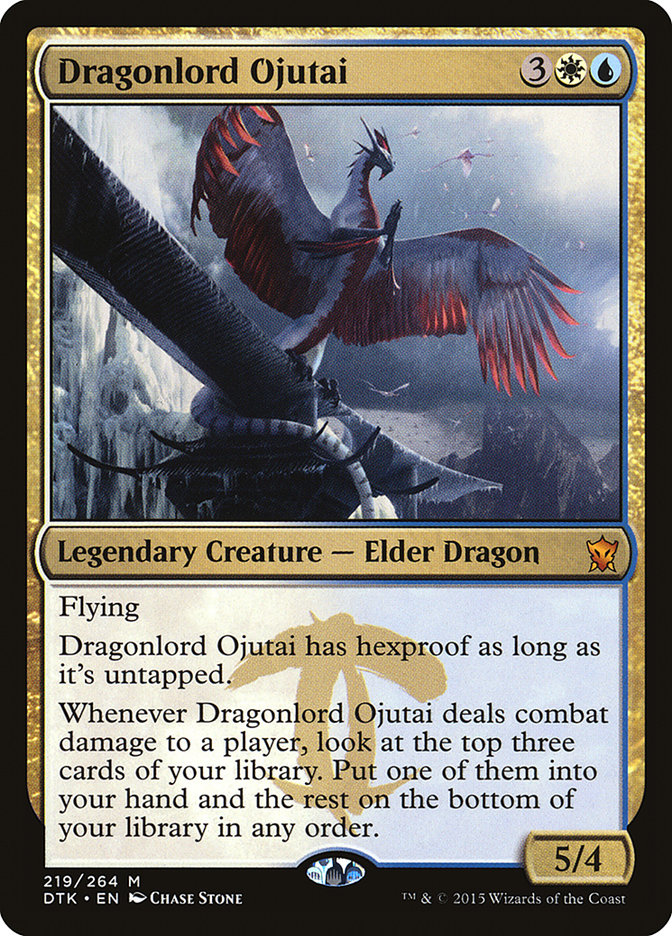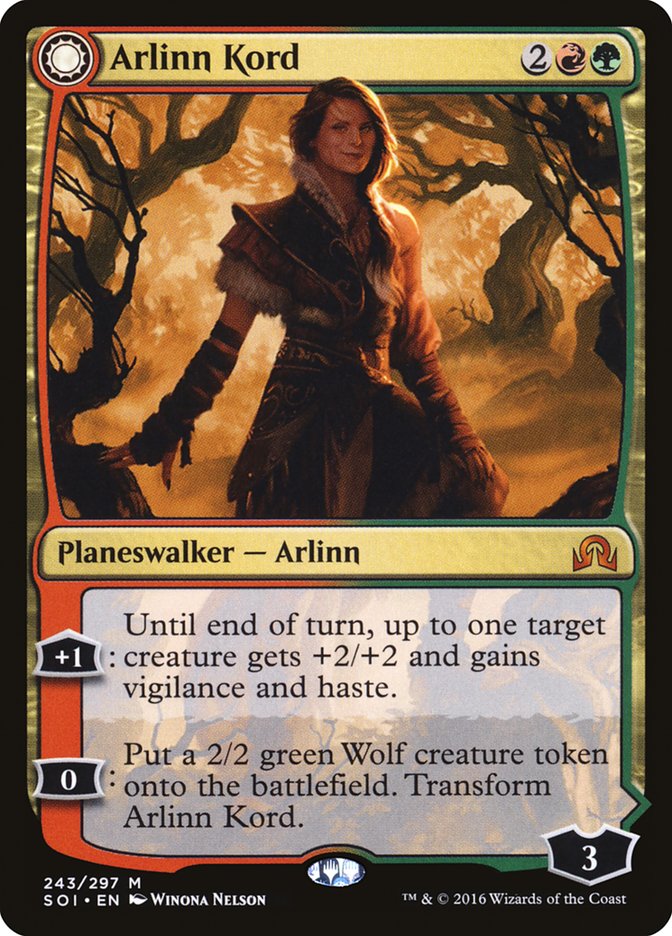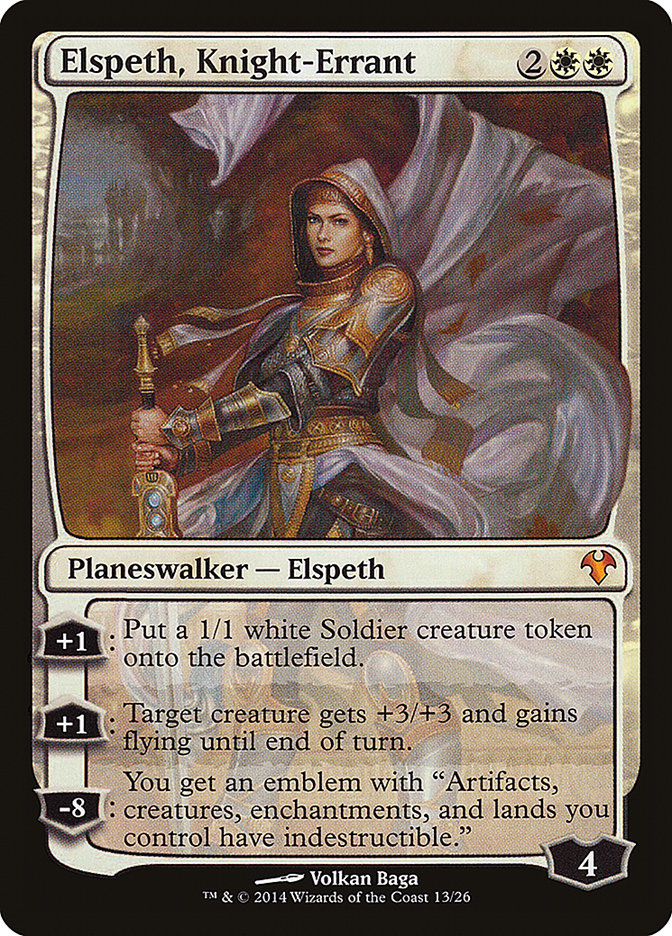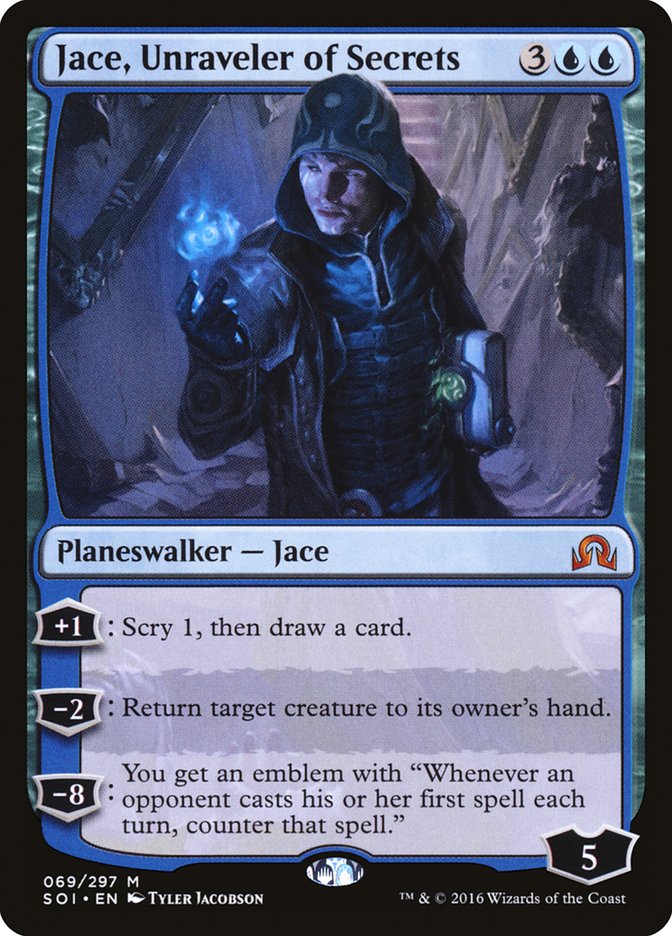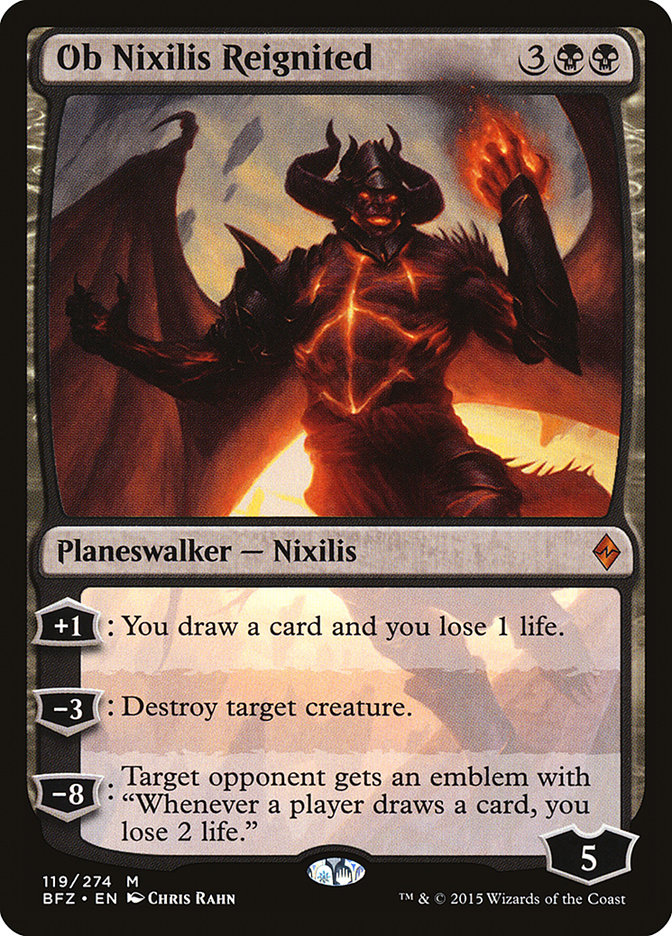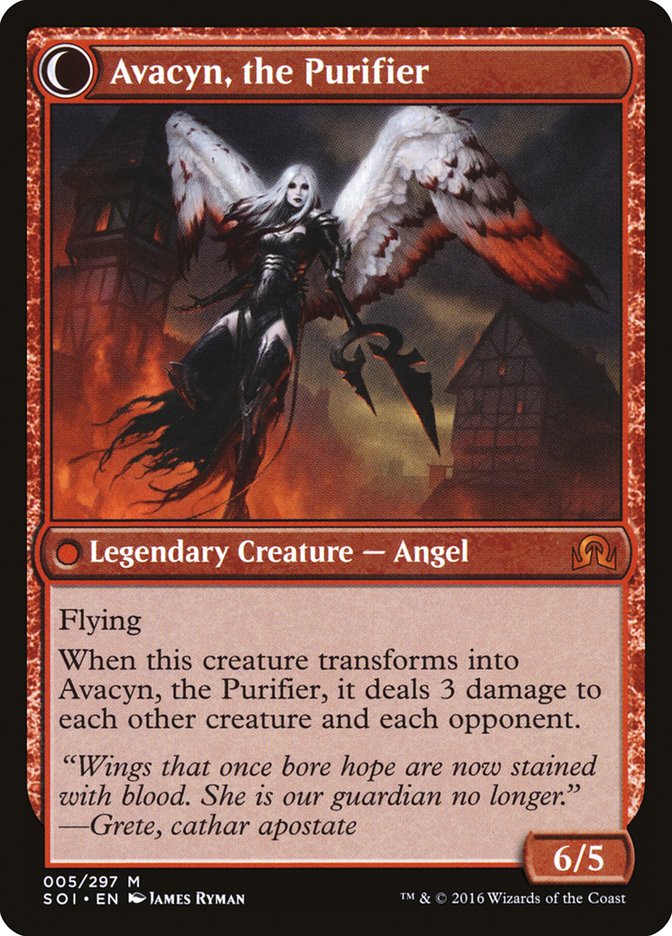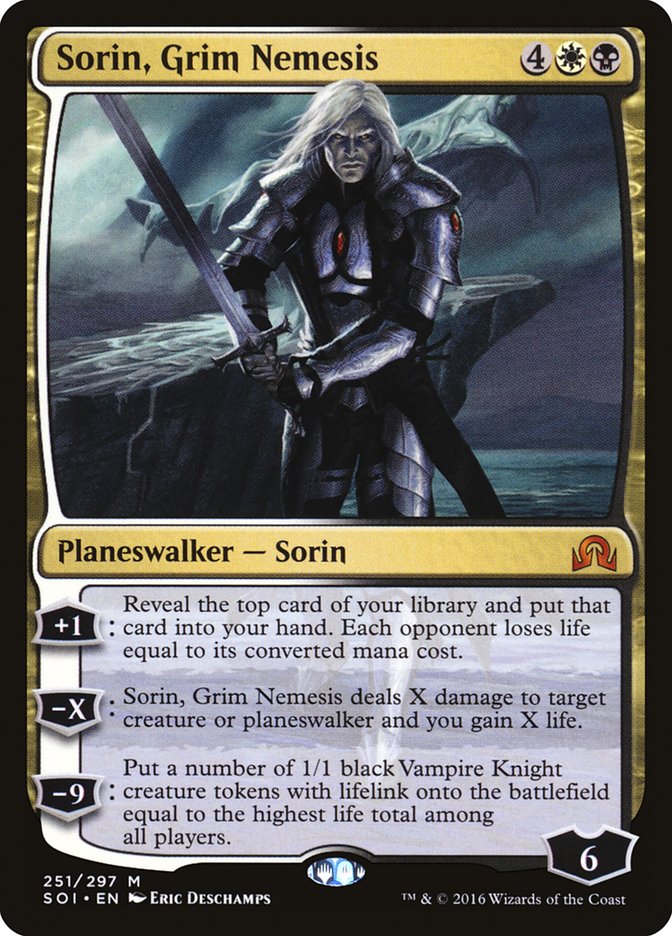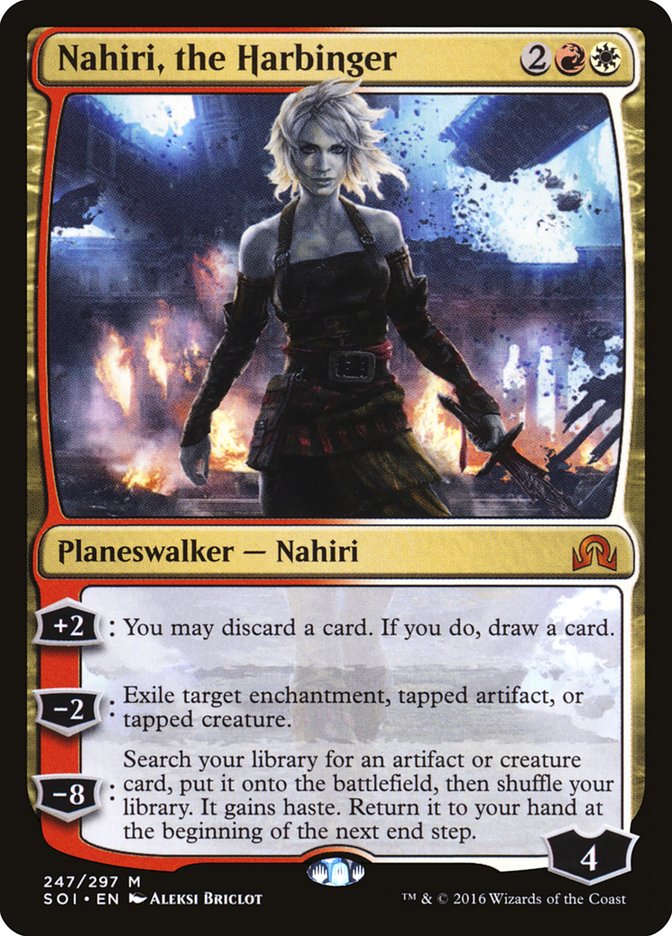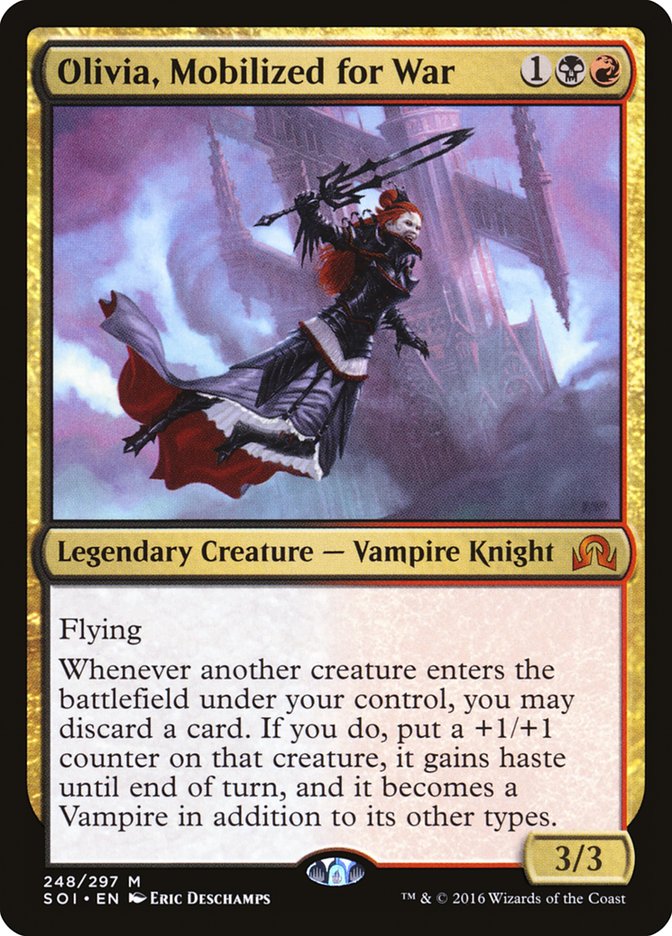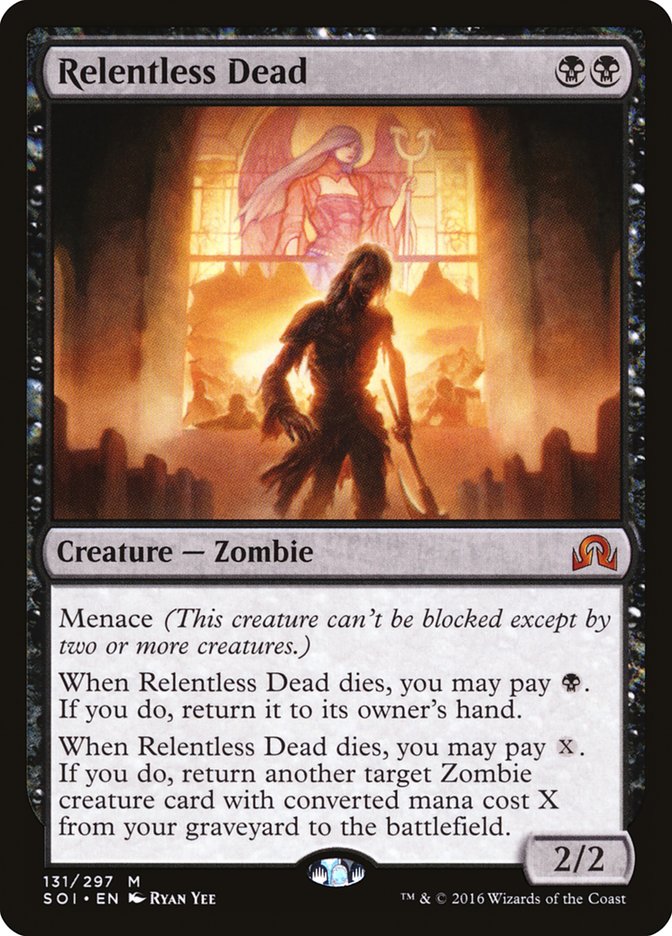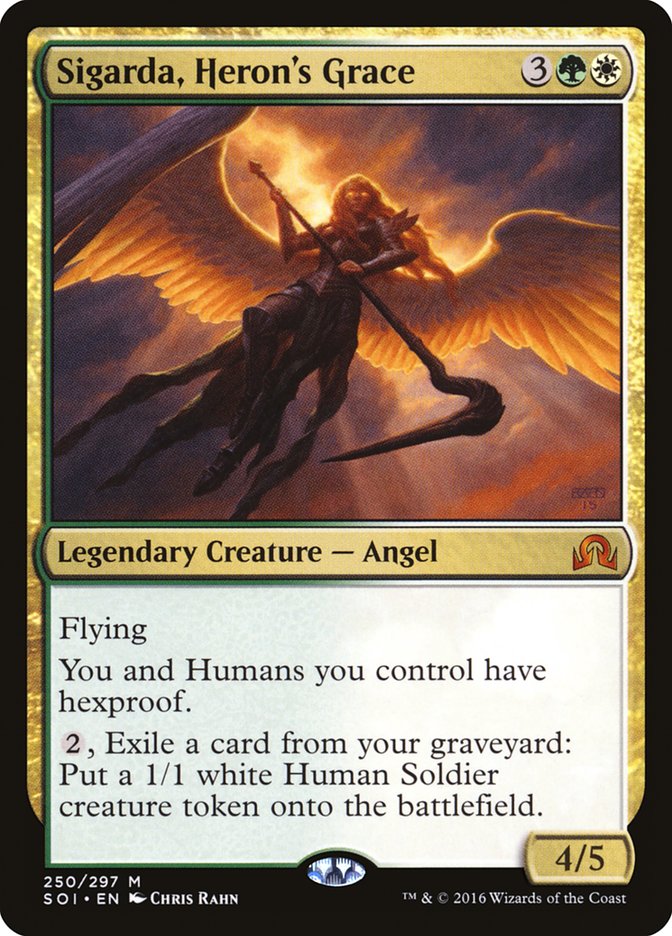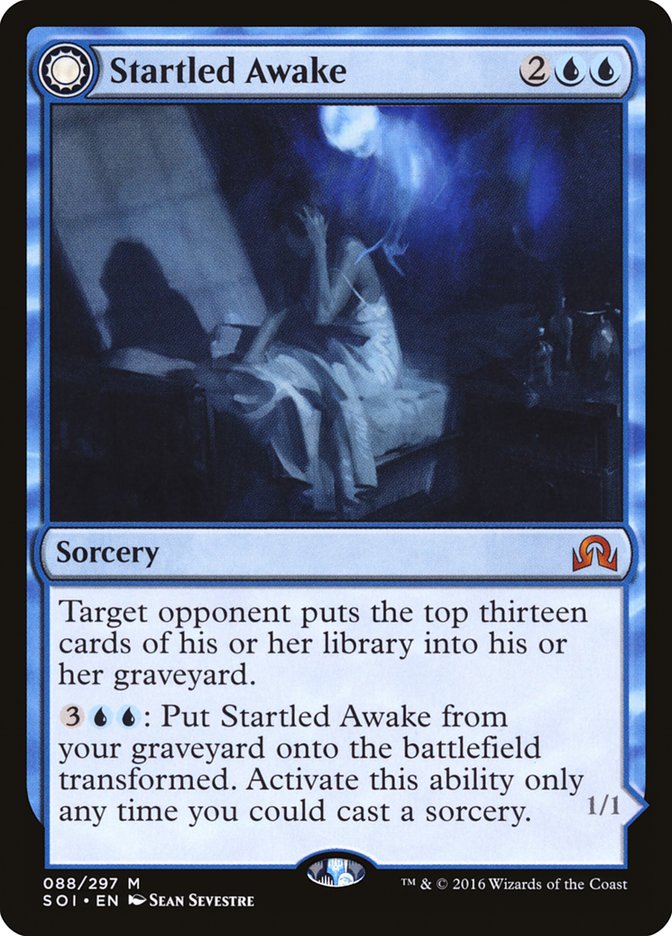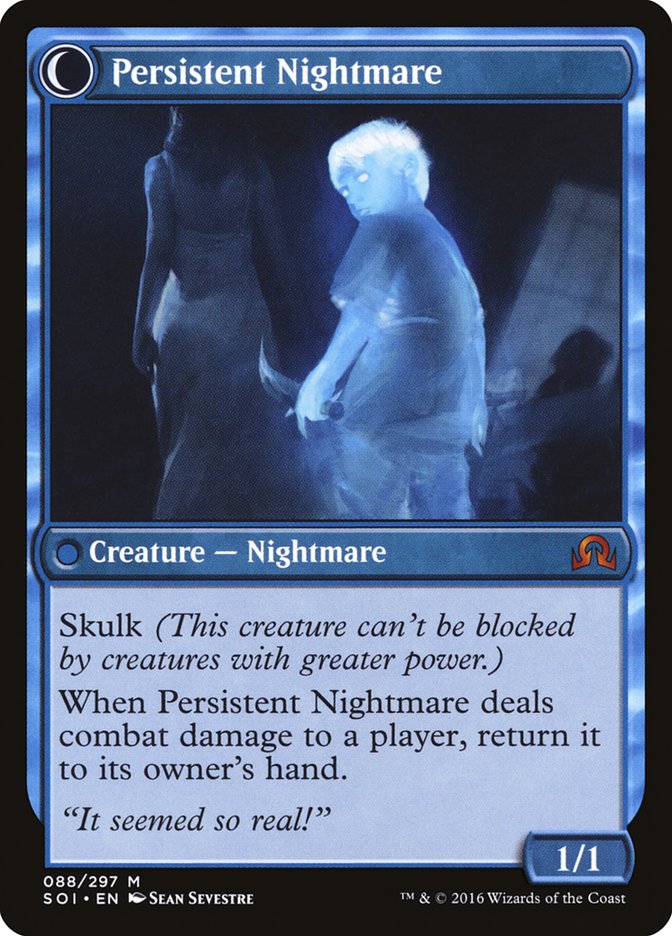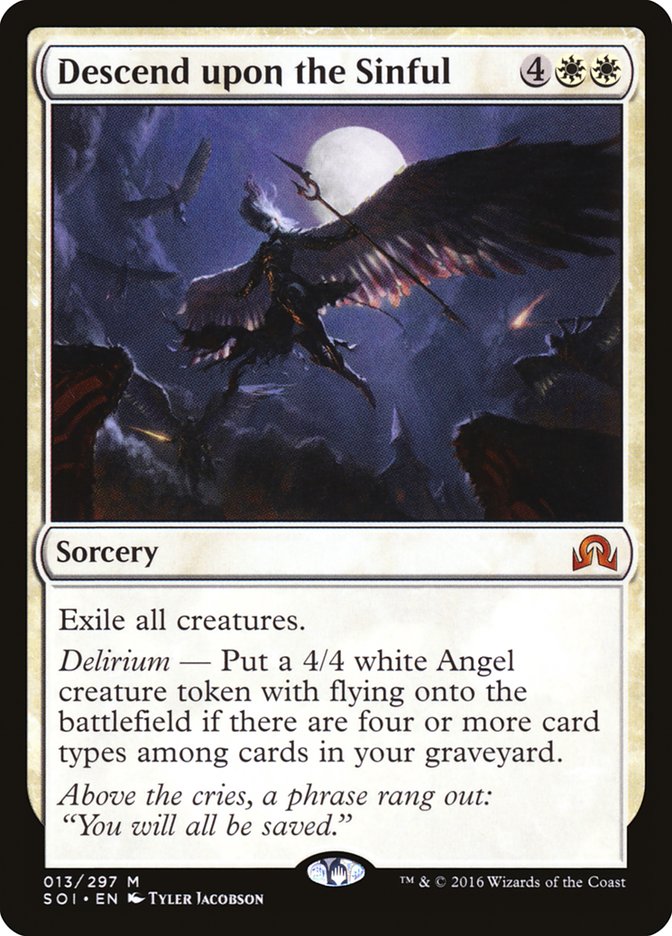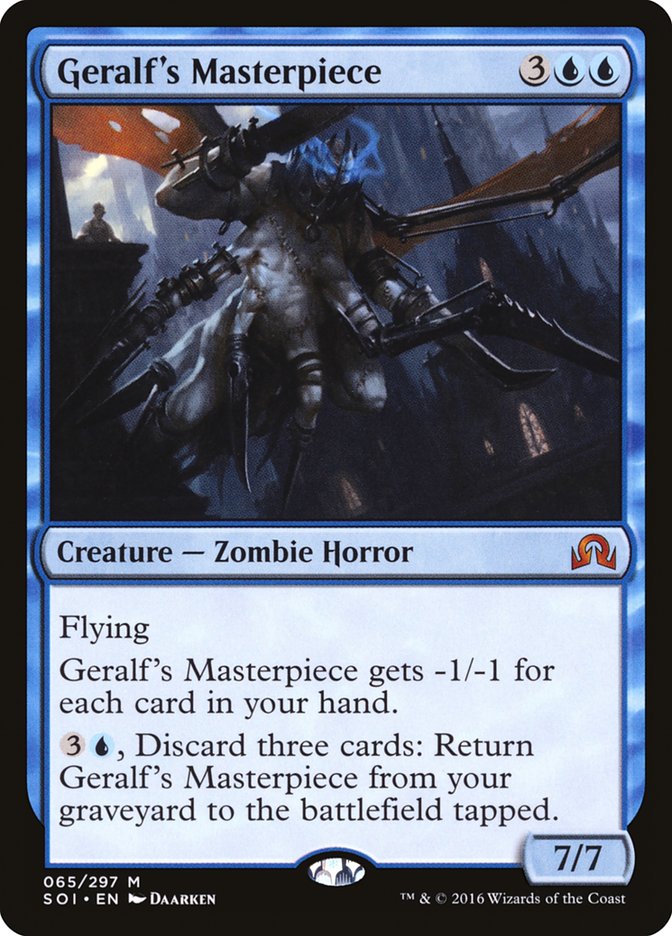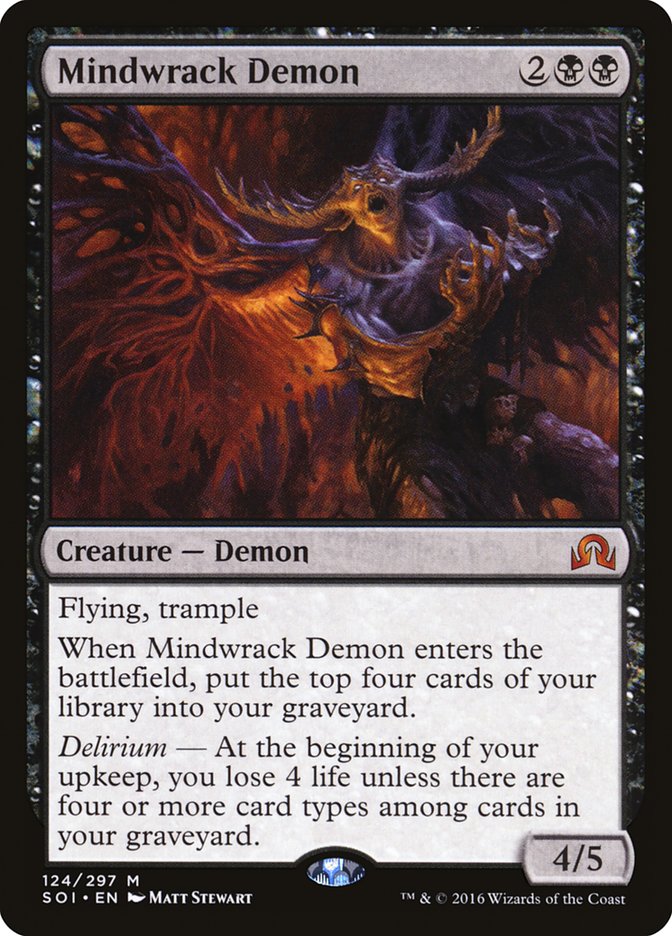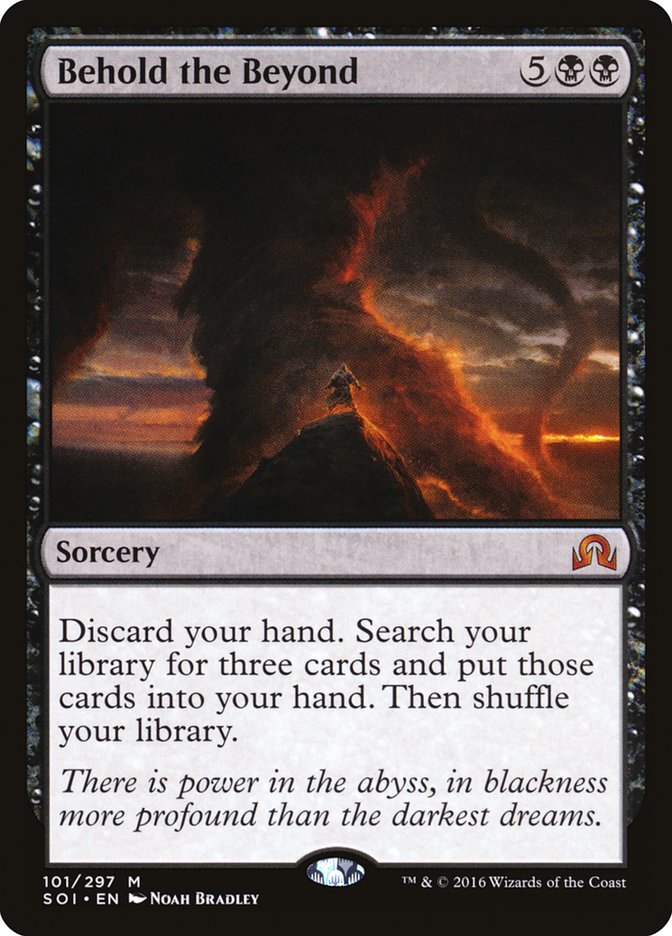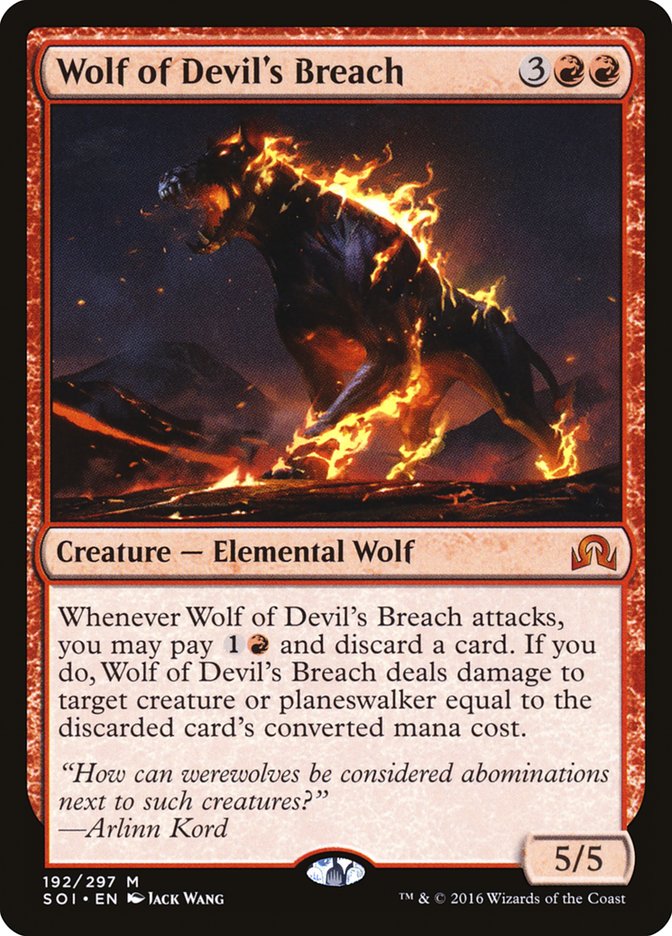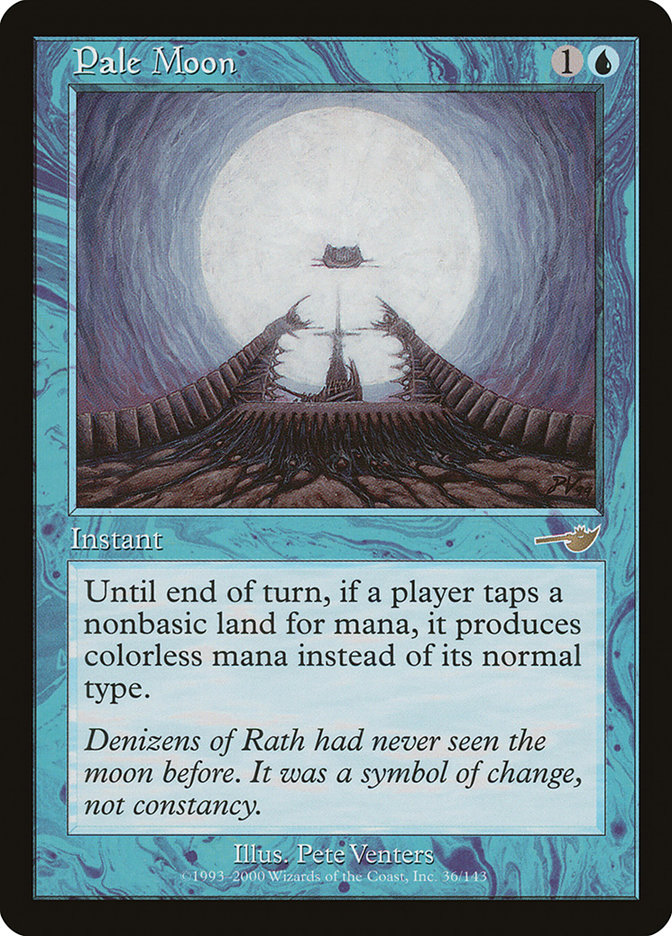Welcome to my first week of Shadows over Innistrad set reviews! As usual, I’ll be starting with the currently-spoiled mythic rares. I’ll take on the rares as well as the rest of the mythics next Monday.
Overall, Shadows looks like a deep and exciting set at mythic. There are more planeswalkers than normal as well as a couple of creatures that appear to be slam-dunk playables in historically successful decks. Unfortunately, this means that the chances of any single mythic breaking out are lower than normal. All in-print Magic sets have a price ceiling dictated by the wholesale price of sealed product, so a deep set generally works against the formation of a single $40-$50 staple. That doesn’t mean a card like Arlinn Kord can’t go nuts for a while, but I find it highly unlikely that we’ll find the next Jace, Vryn’s Prodigy anywhere in Shadows.
My favorite spec targets in these set reviews are mythic rares that are both inexpensive and hard to evaluate. This usually only comes up when there’s a new mechanic—miracles, say—that ends up playing a lot better than it looks at first glance. Sometimes these cards can appear in unexpected places—the Dragonlords from Dragons of Tarkir, for example. Unfortunately, I don’t see any mythics in Shadows over Innistrad that fit this bill yet; too many of this set’s mythic rares already look good.
Since so many of the new mythics are already above average price points, we’re going to have to look and see if any of them aspire to real greatness. And what makes a mythic rare great? Versatility. Part of the reason that Jace, Vryn’s Prodigy is so much more expensive than Dragonlord Ojutai ever was is that Jace is a key part of multiple decks while Ojutai—even at its best—was only good in one. Lots of things affect versatility, but the most important is mana cost. Gold cards and five-plus-drops are the least likely to see play in multiple decks, while mono-colored cards and cheaper spells tend to be more versatile.
With all of that in mind, I’m trying something slightly different in my set review this time around. After each review, I’ll provide you with a prediction on the ceiling, a floor, and realistic outcome of each card. When I talk about a card’s ceiling, I’m referring to the top 10% best possible outcome—if everything breaks exactly right, this is what the price should do. Ditto the floor—if the bottom 10% outcome has come true, this is what the card’s value will be. The “realistic outcome” is my safe prediction—assuming things progress as I see them, this is where the card’s price should end up by the middle of next month.
Why not make a single subjective prediction and be done with it? I don’t find that to be a very useful exercise when evaluating new Magic cards. There is too much variance and too much we still don’t know about the future metagame. I prefer to think about different paths a card can take, putting extra emphasis on expensive cards with high floors and cheap cards with high ceilings. Are there any hidden gems lurking in Shadows over Innistrad? Let’s take a look.
Arlinn Kord / Arlinn, Embraced by the Moon – $39.99
Hoo boy, do people love Arlinn Kord. I might be more critical of the price if I didn’t count myself among Arlinn’s many fans—flip planeswalkers are great, Werewolves are cool, and I’ve wanted this exact card to be printed since the last Innistrad set. I can’t think of a card I want to open more at the Prerelease than Arlinn.
There’s no question that Arlinn Kord is powerful enough to be a Standard staple. At four mana, she’s powerful enough to draw favorable Elspeth, Knight-Errant comparisons, which should tell you all you need to know.
The real questions are: 1) How many Tier 1 decks will be able to handle a 2RG casting cost, and 2) Is Arlinn playable in Modern as well?
I’m a little bearish on both of those things, unfortunately. That doesn’t mean that I don’t love Arlinn—she’ll be played in a very good deck and she’ll be absurd often enough to excite people, but I don’t think she’s good enough to carry, say, a Tier 1 R/G aggro deck as well as a Tier 1 Jund or Abzan midrange list. And while Arlinn Kord might make the occasional appearance in Modern, I think it’ll mostly be limited to Naya Zoo and maybe a one-of in Naya Company. She’s just a little too aggressive for the current breed of Jund decks, which are more grindy and attrition-based. Put all that together and I don’t think you get a $40 card.
· Ceiling: Instant Standard and Modern staple. Think Liliana of the Veil when she was in Standard—$50 price tag with peaks at $60+.
· Floor: $12-$15 second-tier Standard staple that just can’t find the right Tier 1 deck.
· Realistic Outcome: $20-$25 top-tier Standard staple.
Jace, Unraveler of Secrets – $29.99
I’ve seen a lot of people liken Jace, Unraveler of Secrets ($30) to Ob Nixilis Reignited ($8). Is this a fair comparison? Let’s go point by point and find out.
First off, both planeswalkers have similar mana costs—3UU for Jace vs. 3BB for Ob Nixilis. They both start off with five loyalty and they both have a plus-one that draws a card. Jace’s deal is far better, though: “scry 1, then draw” is worth about a card and a half, while Ob Nixilis’s “draw one and lose one life” is more like 0.85 of a card.
Both planeswalkers have a secondary ability that deals with a problematic creature. Ob Nixilis’s ability is better, but it costs one loyalty more. This is significant: with no pressure, Jace can minus-two twice and stay alive. Ob Nixilis can only minus-three once before you’re forced to use the plus-one. Jace’s ability also plays well with your own enters-the-battlefield creatures, though I expect that to be more of a corner case. Last, both cards have a minus-eight ultimate that is very hard to beat.
I think it’s safe to say that Jace, Unraveler of Secrets is a better card than Ob Nixilis and probably quite a bit better. The biggest problems I have with Jace are that: 1) It’s very hard for a five-mana planeswalker to see play as more than a three-of in a couple of decks, and 2) It plays very poorly with a flipped Jace, Vryn’s Prodigy. On the other hand, there’s only been one bad Jace ever, and Jace, Unraveler of Secrets is far better than the forgettable Jace, the Living Guildpact.
Does that mean it’s time to pre-order? Not quite. Chandra, Flamecaller is a realistic ceiling for Jace’s playability, and she has yet to break $25. I can easily see Jace dropping down to the $15-$20 mark during the first few weeks of the new Standard environment, regardless of where he ends up down the road. Unless Jace, Unraveler of Secrets is twice as good as everyone thinks it will be, its best chance to experience a sustained price tag anywhere near $30 is after Jace, Vryn’s Prodigy leaves Standard. I’m holding off for now.
· Ceiling: $35 with peaks at $40, like Jace, Architect of Thought but better.
· Floor: $6-$8, occasional play in fringe control decks.
· Realistic Outcome: $15-$20 staple planeswalker.
Archangel Avacyn / Avacyn, the Purifier – $24.99
At first glance, Archangel Avacyn seems absolutely incredible. How might games with Avacyn actually play out, though? Let’s think it out turn by turn.
Avacyn is obviously great whenever there’s a clogged board. If you’re attacking in a roughly even position, she can probably save a creature or two. If you’re blocking, she’s even better. If your opponent knows you have Avacyn in your deck, they’re going to be terrified every time they attack into five open mana.
What about the flip aspect of the card? That takes some work to set up. Since your creatures are indestructible the turn you cast her, the earliest she can flip is two upkeeps later unless you’ve got a sacrifice engine online. So if you play her on your opponent’s turn, the earliest she’d flip is your opponent’s next upkeep step. That’s still plenty strong, but you can’t exactly plan around it. Too much can go wrong, including your opponent simply killing Archangel Avacyn with a removal spell.
Could Avacyn see play in more than one top deck? Because of her skill in combat and the amount of control you have to cede to your opponent over the flip ability, I like her a lot more in midrange than control. Will there be more than one white-based midrange deck? It’s possible but unlikely. At $25, I’m staying away.
· Ceiling: $20-$25 staple in multiple midrange decks.
· Floor: $5-$6 beloved casual and Commander card.
· Realistic Outcome: $8-$12 role-player in a very good deck and fringe-playable in a few others.
Sorin, Grim Nemesis – $24.99
I have no doubt that Sorin, Grim Nemesis will see play in a good Standard deck. Six starting loyalty is a ton, especially with a very good plus-one and a game-winning ultimate that gives you some pretty serious inevitability. The minus-X shouldn’t be overlooked, either, and sometimes Sorin will just come down, kill a creature, and gain you six life. Because of that, it’s possible that a control deck might want to run more than one or two of these—dropping Sorin, minus-sixing him, and following that up with a second Sorin the following turn seems great to me.
Even so, how many decks are going to want Sorin? We’re going to need a B/W or Esper Control deck to emerge for him to see play at all, and we’d need both to exist simultaneously if you expect him to stay at $25—he isn’t a four-of in any deck regardless. Casual demand should keep his floor pretty high, but his ceiling is equally low.
· Ceiling: $18-$20; three-of staple in two good control decks.
· Floor: $7-$8 beloved casual and Commander card.
· Realistic Outcome: $10-$12 finisher in B/W or Esper Control.
Nahiri, the Harbinger – $19.99
I don’t think we can properly evaluate Nahiri, the Harbinger until we know a little more about Shadows over Innistrad. There haven’t been all that many good madness cards printed yet, which makes her plus-two ability look really underwhelming at the moment. If you’re using it to cast Fiery Tempers while drawing a card, game on. If you’re not gaining any card advantage while looting, I’m out.
Likewise, her minus-two ability is merely okay. It’ll nail a problematic creature some of the time, but other times, you’ll be sitting there gritting your teeth while staring at a wall of blockers. I’ll assume that her ultimate reasonably approximates “win the game,” but that’s true of almost every planeswalker in Standard.
My biggest problem with Nahiri? That restrictive mana cost. R/W is just about the worst color pair you can ask for, and the fact that she requires two colors to cast makes her competitive application very narrow. She might find a home and impress us all, but it’s far more likely that the right deck just won’t come along. I’m also skeptical that WotC is going to give us too many great cards with madness—we might not remember U/G Madness in its heyday, but you’d better believe the folks in R&D are very conscious of it.
· Ceiling: $20 with peaks at $25; top tier Madness enabler.
· Floor: $6, shows up in some Commander decks and budget brews.
· Realistic Outcome: $8 fringe player in Standard.
Olivia, Mobilized for War – $19.99
Olivia, Mobilized for War is awesome, and it sure does look like WotC is giving us a pretty linear R/B aggro deck that will likely have game in Standard. Relentless Dead certainly loves Olivia, though I haven’t seen a ton of top-tier madness cards yet. Fiery Temper, sure, but what else is out there so far?
I also doubt that Olivia, Mobilized for War will see play in multiple decks. Other than R/B Vampires (or Zombies with a single Vampire), you’re looking at trying to shoehorn Olivia into something like Jund Company, which is a tad ambitious. 1BR isn’t all that expensive, but it is quite restrictive. In that way, this card reminds me a lot of Drana, Liberator of Malakir, a similarly aggressive three-drop that took a while to finally catch on.
I like Olivia and I do suspect she’ll find a home, but there’s no reason to buy in at $19.99. She’ll be $8 if she doesn’t find a home right away, and that’s the point when I’d start to consider buying a couple of copies. Until then, stay away unless you’re building R/B Aggro for yourself and you don’t mind taking a possible loss.
· Ceiling: $25 with peaks at $30; four-of staple in an R/B aggro and an R/B mid-range deck.
· Floor: $5 if R/B turns out not to be a playable color pair in the new Standard format.
· Realistic Outcome: $15 staple in one top-tier deck.
Relentless Dead – $19.99
I love two-mana mythic rares. The best of them—like Jace, Vryn’s Prodigy—have the chance to be playable everywhere. Relentless Dead is really versatile, too—not only is it a really hard creature to deal with in aggressive decks, but it can block for approximately forever.
The real test for this card is going to be how many decks can afford a two-drop with a casting cost of BB. If it ends up in, say, R/B Aggro and B/W (or U/B) Control, we’re talking about a $25-$30 mythic rare and the most obnoxiously expensive card in the set. Otherwise, I see it settling in somewhere near $15.
· Ceiling: $30-$35 multi-format staple and multi-deck Standard all-star.
· Floor: $6-$8 head-scratcher while people try to figure out why black is so bad in this set despite having looked great in the spoiler.
· Realistic Outcome: $16-$20 staple in one top-tier deck and a strong player in multiple Tier 2 lists.
Sigarda, Heron’s Grace – $7.99
Sigarda is a hard card to evaluate at a glance because it really seems like she should have hexproof herself. She doesn’t, though; her ability is more in line with Leyline of Sanctity or Aegis of the Gods than the original Sigarda, Host of Herons. Aegis of the Gods wasn’t that great because it was easy to kill, and Leyline is amazing because it’s (in most cases) free to play and burn decks have a hard time dealing with enchantments. So what about Sigarda, Heron’s Grace, who falls somewhere in between?
Burn decks are still going to have issues with Sigarda; they’re going to have to find a way to deal her five damage or exile her before they can target you with an Edict or a Fiery Temper or whatever. She’s a reasonable clock for five mana, too, and there will be times when her activated ability will just take over a game. At the very least, I expect her to see some sideboard play. Otherwise, it’s going to take a Tier 1 G/W deck that wants at least three of these before the price goes above $10. That’s not unreasonable, but it’s a lot to ask for until we see what the new version of Standard starts to look like.
· Ceiling: $25 top-tier finisher with peaks at $30, like a slightly worse Dragonlord Ojutai.
· Floor: $3 casual mythic bordering on bulk status.
· Realistic Outcome: $5-$7 sideboard card/staple in second-tier Standard deck.
Startled Awake – $5.99
Startled Awake is strictly a casual card. Kitchen table mages love their big mill spells, and this is one of the best ever printed. I can’t see a world where this makes a splash in competitive Magic, though, so the price should slowly drop as packs are opened.
As Wes Wise wrote in his “Daily Value” article, this is going to be a $10 card at some point in the future. I’m ignoring these for about six months and then buying in around $2.50/copy.
· Ceiling: $10 mythic that perfectly complements a currently unspoiled top-tier mill spell in some weird new deck.
· Floor: $2 casual mythic with long-term upside.
· Realistic Outcome: $3-$4 casual mythic with long-term upside.
Descend upon the Sinful – $4.99
It takes a lot for a six-mana Wrath to be good. If you want to play Descend upon the Sinful in a world where Languish and Planar Outburst still exist, that means you’re expecting to get the 4/4 Angel almost every time. Jace, Vryn’s Prodigy certainly goes a long way toward making that dream come true, but there won’t be any fetchlands in the format to help rack up a fast delirium count. It’s not a bad strategy in, say, a U/W or Esper shell if the format is slow enough, but there are going to be a lot of Vampires and Zombies kicking around. I also can’t see Descend upon the Sinful working in more than one deck; you’re either playing some sort of U/W Delirium build or you’re running a faster Wrath.
· Ceiling: $7-$8 four-of role player in U/W Delirium Control .
· Floor: Bulk mythic.
· Realistic Outcome: $3-$4 fringe player in some builds of U/W.
Geralf’s Masterpiece – $4.99
I’ve heard a lot of Skaab Ruinator comparisons with Geralf’s Masterpiece, but they’re very different cards. Skaab Ruinator needed three creature cards in your graveyard before you could cast it, while Geralf’s Masterpiece can be cast from your hand on turn 5. They’re similar in that they can both be cast from the graveyard—Skaab Ruinator needs three blue mana and three creature cards in the graveyard, while the Masterpiece requires four mana and three cards out of your hand.
The thing that links both of these cards? Much like Skaab Ruinator, I doubt Geralf’s Masterpiece will make too big a splash on the Constructed Magic scene. No one really wants to pay five mana for a generically big flier in the first place, and discarding three cards to get it onto the battlefield from the graveyard is just too high a cost. I’ve heard some rumblings about this in a Modern shell with Life from the Loam, but that seems ambitious in a format that has to deal with (among many other things) turn 3 Karn Liberated.
· Ceiling: $7-$8 control finisher in Standard and fringe playable in Modern.
· Floor: Bulk mythic.
· Realistic Outcome: Bulk mythic.
Mindwrack Demon – $2.99
Mindwrack Demon is a 4/5 trampler for four mana! Anyone remember the last time we saw one of those? Oh yeah, that’s right—
Granted, Siege Rhino had additional upside while Mindwrack Demon has some downside, but I don’t think we can dismiss this card as entirely unplayable. Could this be a curve-topper in B/R Aggro? It’s not that synergistic with most of those cards, but it has enough raw power to be at least worth considering.
Financially, Mindwrack Demon is hampered by its inclusion in Duel Decks: Blessed vs. Cursed, which also has a Geist of Saint Traft. Inclusion in a Duel Deck kept Polukranos’s price pretty low during Theros Standard, and I doubt Mindwrack Demon has a shot at breaking $10 because if that. There’s still some nice upside at $3, though—I’m in for a copy or two.
· Ceiling: $8-$10 four-of finisher in a Tier 1 aggro deck.
· Floor: Bulk mythic.
· Realistic Outcome: $3-$5 second-tier aggro finisher.
Behold the Beyond – $2.99
Did this really have to be a sorcery? At instant speed, it might have been an interesting spell. As a seven-mana sorcery, it doesn’t have any game in either Standard or Modern outside of some very rogue applications with Living Lore.
Could Beyond the Beyond work in Legacy or Vintage, perhaps as a Storm finisher or something something Omniscience? If so, it’ll be a one-of in a couple of Tier 2 lists. Foils might be a nice buy on the off-chance this card hits its ceiling, but I doubt even Vintage and Legacy play could keep non-foils away from bulk mythic status.
· Ceiling: A bulk mythic where the foil is worth $30 thanks to Vintage or Legacy.
· Floor: Bulk mythic.
· Realistic Outcome: Bulk mythic.
Wolf of Devil’s Breach – $2.99
Wolf of Devil’s Breach is a 5/5 for five mana with no evasion, no static abilities, and no enters-the-battlefield effects, plus you have to attack with it in order to do anything. These are not the hallmarks of a Constructed-playable card. Pass.
· Ceiling: $4-$5 fringe player in some kind of weird Madness deck.
· Floor: Bulk mythic.
· Realistic Outcome: Bulk mythic.
This Week’s Trends
Standard gainers this week: Kalitas, Traitor of Ghet; Chandra, Flamecaller; Drana, Liberator of Malakir; Nissa, Voice of Zendikar; Risen Executioner; Sidisi, Undead Vizier; Avaricious Dragon; and Liliana, Heretical Healer. Thunderbreak Regent is also seeing some action online that hasn’t crossed over into paper yet. All these cards have some post-rotation game, so I’m not surprised they’re starting to rise. People expect there will be at least one (and possible more than one) aggressive R/B list as well as a more controlling black deck, and I don’t think they’re wrong.
In the meantime, lame-duck Standard is still a pretty great format. Take a look at this Super IQ Top 8, which has eight totally different decks and play styles represented. If you’re already committing to keep your rotating Stnadard cards through rotation, get out there and enter an event or two in the meantime.
Over in Modern, the “Eight Whack” Goblin deck is the latest fun budget brew that’s actually putting up decent numbers online. The key cards are Legion Loyalist, Goblin Chieftain, and Goblin Piledriver, all of which have seen major gains as more people decide to build the deck. I doubt it’ll crack Modern’s top tier at any point, but it could cause Loyalist and Piledriver to keep climbing. Ditto Goblin Guide—if you want to play the deck in a major event, adding four of those is an absolute must.
Hall of Gemstone was the latest victim of Reserved List buyout shenanigans, and I expect this one will stay reasonably expensive. It’s a unique and decent effect in mono-green Commander decks, and the current (very limited) supply should be able to sustain a $10-$15 price tag.
You know what else was bought out this week? Pale freaking Moon. That’s right! The worst card of all time according to Ben Bleiweiss is now a hot spec target. I suppose it makes a weird sort of sense—Eldrazi decks in Legacy can run the card as their own sort of Blood Moon—but is that really going to happen? I doubt it, but I really hope so. Any world where Pale Moon is playable in Legacy—Legacy!!—is a world I absolutely want to live in. I don’t recommend buying Pale Moon, but you should pick them out of your bulk. You should also follow that link and read Ben’s old “worst card” series—it’s probably the most fun thing ever published on StarCityGames.com.



